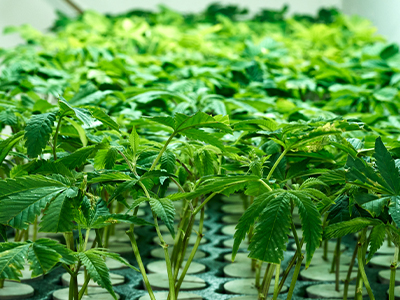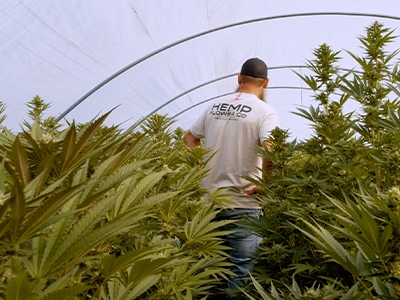Oregon’s reputation as a premier hemp producer continues to expand beyond traditional outdoor grows and fertile valleys. An increasing number of farmers are turning to indoor cultivation to ensure consistent quality and innovative strain development—even during off-season months. By harnessing advanced technology, meticulous breeding programs, and data-driven processes, these cutting-edge indoor operations are reshaping the landscape of hemp flower production.
Among the vanguard is Hemp Flower Co., an Oregon-based farm recognized for sustainable, high-tech approaches to hemp cultivation. Michal P., Founder of Hemp Flower Co., has witnessed firsthand the transformative effects that indoor farming can have on yield quality, environmental control, and consumer satisfaction.
“Indoor hemp farming isn’t simply a shield against rain or extreme weather,” explains Michal P. “It’s about creating a highly controlled environment—where temperature, humidity, and light exposure are precisely managed—to unlock each plant’s genetic potential.”
Pioneering Techniques That Elevate Quality
-
Smart Lighting Systems - Oregon’s indoor cultivators rely heavily on full-spectrum LED lights that can be fine-tuned to different growth stages. Adjusting these light cycles enables farmers to accelerate or extend the vegetative period, pushing plants toward robust flowering. Beyond mere illumination, some systems use automated dimming and color spectrum shifts to mimic natural day-night cycles, thereby encouraging healthier growth and optimized cannabinoid production.
-
Automated Climate Control - Preventing mold, mildew, and pest infestations remains a top priority for any high-density grow environment. Modern indoor hemp farms employ real-time sensors and sophisticated HVAC systems to maintain ideal temperature and humidity levels. This automated setup allows for swift adjustments when, for example, an unexpected spike in humidity threatens plant health. Over time, these micro-adjustments promote a stress-free environment for plants, which can lead to higher yields and more potent hemp flowers.
-
Precision Feeding and Nutrient Management - The latest irrigation and nutrient-delivery systems rely on advanced data analytics to determine exactly how much water or fertilizer each plant needs based on factors such as soil composition, pH, and plant size. These “smart” dosing methods reduce waste, promote healthier root development, and improve overall cannabinoid and terpene profiles in the final product.
“By collecting data at every stage—from seedling to harvest—we can fine-tune variables that were once impossible to control,” says Michal P. “That means improved consistency and reliability, which is critical as the hemp market becomes increasingly competitive.”
Strains Geared Toward Indoor Success
One of the most significant developments in Oregon’s hemp industry is the deliberate breeding of strains specifically tailored to indoor growing conditions. At Hemp Flower Co., the breeding program focuses on strains like “Evergreen Dream,” prized for its pine-forward terpene bouquet, and “Ocean Mist,” an indica-leaning hemp variety with a higher concentration of minor cannabinoids and a calming aroma.
“We’re not just breeding for maximum potency or minor cannabinoid content,” Michal P. notes. “We want plants that flourish under artificial lighting, demonstrate strong pest resistance in controlled environments, and consistently produce distinctive terpene profiles.”

Meeting Consumer Demand and Regulatory Standards
As the hemp sector grows, so do consumer expectations. Today’s buyers are often well-informed about cannabinoid ratios and the importance of a rich terpene profile. By refining indoor cultivation methods, Oregon farmers can meet these demands and safeguard product quality year-round. Additionally, strict Oregon Department of Agriculture (ODA) guidelines ensure that all indoor-grown hemp remains under the 0.3% Delta-9 threshold required by the 2018 U.S. Farm Bill.
“Oregon’s regulatory framework actually helps us ensure we’re delivering safe, compliant products,” Michal P. explains. “We conduct regular testing at every major growth phase, so customers know exactly what they’re getting when they pick up an Oregon-grown hemp flower product.”
Looking Ahead
With more cultivators embracing technology, data analytics, and genetics research, Oregon’s indoor hemp landscape promises to continue evolving at a rapid pace. Industry leaders like Hemp Flower Co. are confident that these innovations will cement the state’s position as a global standard-bearer for both sustainability and product excellence in the hemp market.
Disclaimer: All hemp products referenced above are cultivated, processed, and distributed in accordance with the 2018 U.S. Farm Bill, which requires that any hemp-derived product contain no more than 0.3% Delta-9 on a dry-weight basis. At the same time, these products are federally legal.
Media Contact
Company Name: Rise Marketing
Contact Person: Media Relations
Email: Send Email
Phone: 9712639988
Country: United States
Website: https://hemp-flower.com/blogs/news/hemp-flower-co-420-event-thca-deals


